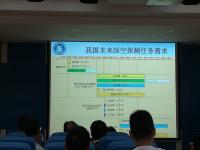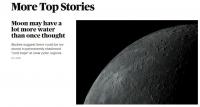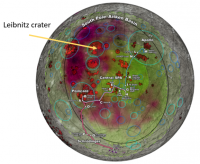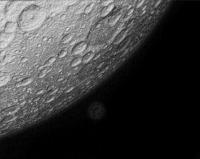Printable Version of Topic
Click here to view this topic in its original format
Unmanned Spaceflight.com _ Chang'e program _ Chang'E 6- Sample Return
Posted by: Phil Stooke Aug 11 2017, 05:46 AM
https://www.chinaspaceflight.com/satellite/Deepspace/CE-6/CE-6.html
CE-6 now being touted for 2020 and a south polar target. The rim of Shackleton crater is suggested, probably just for a mission simulation rather than serious site planning at this stage. I had been hearing about two polar landers in the 2023-2025 period (roughly) in addition to and following CE-6, which I had assumed was going to the same general region as CE-4. It will be interesting to see how this all plays out.
Posted by: A.Nemo Jun 4 2019, 02:46 AM
as a copy and backup of CE-5, CE-6 will be launched in 2024.
if CE-5 fails in 2019 or 2020, CE-6 will be launched within two years.
Posted by: bobik Nov 7 2019, 02:20 PM
The French https://els-tlse.sciencesconf.org/data/pages/ELS_2018_Abstract_Booklet_08052018.pdf#page=128 (Detection of Outgassing RadoN) experiment https://presse.cnes.fr/sites/default/files/drupal/201911/default/cp156-2019_-_chine.pdf for a flight to the Moon on Chang'e-6.
Posted by: Huguet Oct 26 2020, 04:59 PM
Since long time we have Chang'e 6, 7 and 8 with focus on solar south pole, now we get Nasa with the south pole water rich findings.
This will be interesting.
https://nssdc.gsfc.nasa.gov/planetary/lunar/cnsa_moon_future.html
https://www.space.com/water-on-moon-shadow-cold-traps-discovery
Posted by: Steve G Oct 26 2020, 09:33 PM
On the subject of the water on the moon announcement, here is a screenshot from the CBS website. Is this a picture of the moon or Mercury that they used?
Posted by: Phil Stooke Oct 26 2020, 10:45 PM
Moon - Rheita Valley is the linear feature. Mare Australe on the limb.
Phil
Posted by: Steve G Oct 27 2020, 02:48 AM
Awesome, thanks!
Posted by: Phil Stooke Mar 21 2021, 05:25 PM
Heard at LPSC: CE7 will fly before CE6. CE7 is an ambitious mission with lander, rover and a hopping component which can fly over a shaded area. CE6 is a second sample return mission.
Phil
Posted by: vjkane Mar 21 2021, 07:54 PM
Phil
Phil, I'm not finding that talk at the LPSC site. Do you recall which section it was in.
For those not registered, here's a link to the abstract: https://www.hou.usra.edu/meetings/lpsc2020/pdf/1755.pdf
Posted by: Phil Stooke Mar 21 2021, 09:07 PM
It was reported verbally in the plenary session on March 17th:
The Scientific Achievements by Chang’E-4 and the New Lunar Samples Returned by Chang’E-5
Lin Y.
This statement was towards the end of the talk. I have to say the talk was not particularly useful if you have been following these missions, no CE5 results reported, just a summary of what to expect. Lin did say in response to a question that the CE5 results would be reported soon, probably waiting for a paper to be accepted.
Phil
Posted by: Phil Stooke Oct 3 2022, 07:42 AM
Here is an abstract about an instrument to be carried on CE6.
https://meetingorganizer.copernicus.org/EPSC2022/EPSC2022-992.html
For me the most important thing is a statement about a landing site:
"Chang’E-6 is expected to launch in 2024 and will soft-land on the lunar far-side at approximately 41°S and 180°E."
That's the first specific statement I have seen. It may change but it's a start. Many other reports say it will go to the South Pole but in the press the pole is often confused with the 'South Pole-Aitken basin' so it's not always easy to know what is intended.
That location is not far from Chang'e 4, inside Leibnitz crater but on the ejecta of Finsen crater (which also provided most of what Yutu 2 has seen so far). Samples would include material from Finsen, Leibnitz and SPA.
Phil
Posted by: vjkane Oct 3 2022, 10:19 PM
Phil
Here is map showing Leibnitz crater and the two reference traverses for the proposed NASA Endurance SPA sampling rover. Chang-E-6 would sample a different area of the SPA.
Posted by: Explorer1 Jan 19 2023, 01:25 AM
A nice article about the replacement for the current relay satellite, in preparation for Chang'E 6. Looks like a NRHOorbit instead of the Lagrange point this time.
https://spacenews.com/china-to-launch-relay-satellite-next-year-to-support-moon-landing-missions/
Not sure exactly how the 1st one will be disposed off though.
Posted by: Cosmic Penguin Apr 25 2023, 01:34 PM
https://twitter.com/CNSpaceflight/status/1650854804996882434 to S43º ±2º, W154º ±4º. Launch scheduled for May 2024 for a 53 days mission.
Posted by: bobik Jul 4 2023, 04:41 AM
The French https://ltu.diva-portal.org/smash/get/diva2:1716946/FULLTEXT01.pdf (Detection of Outgassing RadoN) instrument https://www.news.obs-mip.fr/dorn-lune-radon-mission-atmosphere/ to the Chinese Space Agency (CNSA) in July 2023.
Posted by: Phil Stooke Aug 1 2023, 07:16 AM
https://www.nature.com/articles/s41550-023-02038-1
Open access paper on the landing area. Note that it is not south polar, the thread title is incorrect.
Phil
Posted by: nprev Aug 2 2023, 06:35 PM
Agreed. Topic title changed. ![]()
Posted by: Phil Stooke Apr 12 2024, 06:28 AM
Chang'e 6 is preceded by its relay satellite Queqiao 2 and two little companions, Tiandu-1 and Tiandu-2. The large Queqiao 2 is in a frozen highly elliptical orbit which spends much of its time high over the southern farside, where it will be able to relay data from Chang'e 4 and 6 as well as the polar landers CE-7 and 8. Its companions are in different orbits and are designed to test technologies for future relay systems.
Tiandu-2 took a far infrared image of part of the Moon and a distant Earth:
(CNSA image, contrast stretched)
The largest crater is Landau on the northern far side.
Phil
Powered by Invision Power Board (http://www.invisionboard.com)
© Invision Power Services (http://www.invisionpower.com)




